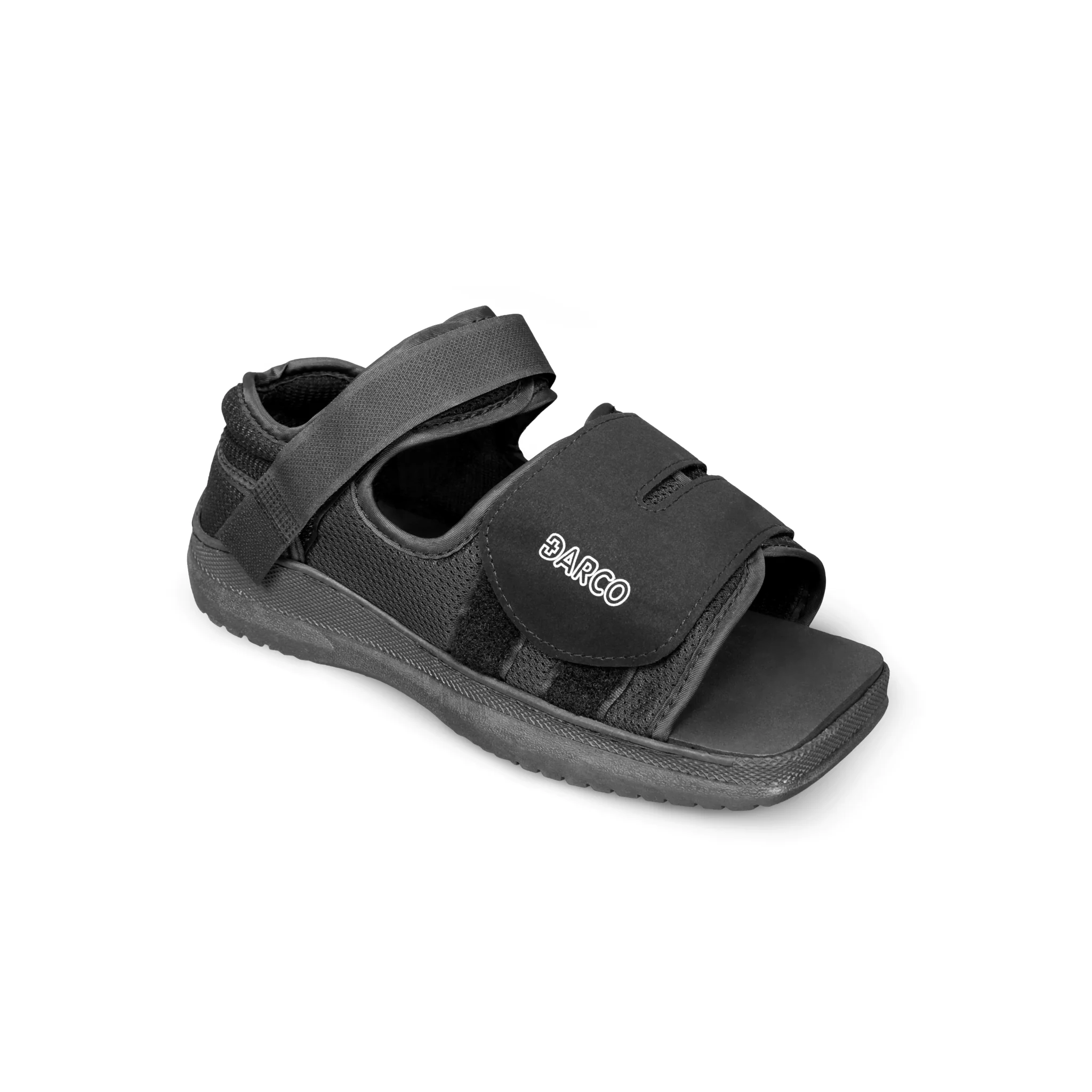See Also:
Rehabilitation goals
- Protect the fusion site and promote bone healing
- Control pain and swelling
- Maintain mobility of adjacent joints
- Gradually restore weight-bearing and gait
- Rebuild strength, balance and function
Expected recovery time
| Milestone | Timeframe range |
|---|---|
| Wound healing and suture removal | 2–3 weeks |
| Initiation of partial weight-bearing | 2–6 weeks |
| Progression to full weight-bearing | 6–8 weeks |
| Transition to normal footwear | 6–12 weeks |
| Improvement in strength and gait | 8–12 weeks |
| Return to low-impact activities | 12–16 weeks |
| Return to full/pre-injury activities | 16–20 weeks |
Phase 1: Early Post-op (0–2 weeks)
Goals
- Protect fusion
- Minimise pain and swelling
- Prevent stiffness in ankle and lesser toes
Instructions
- Non-weight-bearing (use crutches or walker) or toe-touch only in postoperative shoe (see shoe photo above)
- Elevate foot above heart level as often as possible
- Apply ice pack (0–4 °C) for 15–20 minutes, 2–3 times daily
- Keep dressing clean and dry; follow wound-care instructions
- Take prescribed analgesics and DVT prophylaxis
Exercises
- Ankle pumps (10–15 reps, hourly)
- Toe wiggles within pain limits
- Isometric “grip” of toes (press toes down gently into towel, hold 5 s ×10)
- Deep breathing and gentle core engagement
Phase 2: Intermediate Recovery (2–6 weeks)
Goals
- Continue bone healing
- Begin protected weight-bearing
- Maintain ankle and midfoot mobility
- Prevent calf/hamstring stiffness
Instructions
- At ~2 weeks, proceed to partial weight-bearing in boot as tolerated
- Continue elevation and icing post-activity
- Remove sutures per surgeon’s timing (often 2–3 weeks)
- Monitor incision for signs of infection
Exercises
- Ankle circles and alphabet (5 minutes, 2× daily)
- Towel toe curls (gently scrunch towel with toes, 10 reps)
- Seated heel slides (flex/extend knee, 10–15 reps)
- Straight-leg raises in boot (10 reps ×3 sets)
Phase 3: Advanced Recovery (6–12 weeks)
Goals
- Achieve full weight-bearing without boot
- Improve strength of intrinsic foot muscles
- Normalize gait pattern
- Enhance proprioception
Instructions
- Transition into a supportive, stiff-soled shoe at 6–8 weeks
- Discontinue crutches when comfortable, maintain even gait
- Avoid high-impact activities until cleared
Exercises
- Marble pickups with toes (10 reps ×2)
- Resistance-band plantarflexion/dorsiflexion/inversion/eversion (10 reps ×3)
- Standing heel-raises (double-leg → single-leg, 10–15 reps)
- Balance drills (single-leg stand on firm surface, progress to foam)
Phase 4: Return to Activities (12–20 weeks)
Goals
- Restore full functional capacity
- Return safely to low- and high-impact activities
- Maximise endurance and strength
Instructions
- Gradually introduce cycling, swimming, elliptical
- At ~16 weeks, begin gentle jogging or sport-specific drills if fusion is confirmed
- Progress intensity based on comfort and surgeon/therapist clearance
Exercises
- Proprioceptive plyometrics (gentle hops, box-step-downs)
- Sport-specific movements (agility cones, lateral shuffles)
- Progressive resistance training for lower limb
- Endurance walking/hiking as tolerated
When to contact your surgeon
- Fever > 38 °C or chills
- Increasing pain unrelieved by medication
- Redness, swelling or warmth spreading beyond incision
- New or increased wound drainage or bleeding
- Numbness, tingling or loss of movement in foot/toes
- Inability to bear any weight after phased progression
- Signs of deep vein thrombosis (calf pain, swelling)
Disclaimer
This is a general guideline. Your physiotherapist or Dr Lambers may adjust the protocol based on your specific condition and progress.
